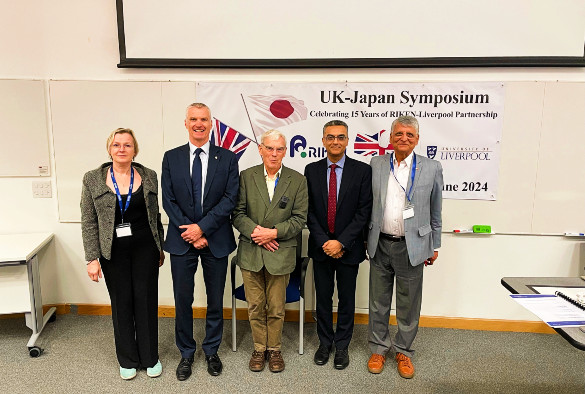
Richard Henderson, winner of the Nobel Prize for Chemistry in 2017, visited the University of Liverpool this week to give a public plenary lecture at the UK-Japan Symposium on the Frontiers of Structural Biology.
The two day symposium, organised by the Institute of Systematic, Molecular and Integrative Biology, brought together UK and Japanese scientists who are engaged in developing and utilizing the frontier methods of structural biology. The extensive programme covered all major structural biology approaches (cryoEM, XFEL, Synchrotron and neutrons) and discussed the latest developments and future plans for the UK-Japan partnership.
Dr Henderson’s lecture explored the developments in cryoEM – a revolutionary imaging technique that he co-developed to help understand the complex structures of proteins, nucleic acids and other biomolecules. It uses frozen proteins and protein-complexes samples to produce more sophisticated imaging methods which enable researchers to capture high resolution images with atomic details of numerous biomolecular structures that previously could not be captured by other means without forcing these systems in crystalline form. This is transforming the face of structural biology which is hugely important for a number of research endeavours – not least the development of pharmaceuticals.
There is still work to be done, however. According to Henderson, imaging is vastly improved in the last 10 years but what would further accelerate research would be access to affordable equipment so that more researchers were able to test their samples quickly and effectively. Rapid progress could be achieved, particularly in drug design, if industry and academia – or even Universities – could work together to find a solution.
Dr Henderson praised the work of the University’s Professor Samar Hasnain and the strong connection he has helped to forge between Liverpool and Japan, where there is significant investment in novel imaging techniques thanks to industrial partners such as Hitachi. He is hopeful that this strong relationship will continue, particularly as the University has a well-established link with RIKEN which is Japan’s largest comprehensive research institution renowned for high-quality research in a diverse range of scientific disciplines. RIKEN encompasses a network of world-class research centres across Japan, with main campuses in Wako, Tsukuba, Yokohama, Kobe and Harima offering state-of-the-art facilities and cutting edge technology.
Professor Samar Hasnain, Max Perutz Professor of Molecular Biophysics, said: “I am grateful to the University for helping me to establish the Barkla X-Ray Crystallographic Laboratory in 2011, recognising the University’s own Nobel Laureate Charles Glover Barkla who contributed to the foundation of X-ray Crystallography. It was an honour to welcome another Nobel Laureate, Richard Henderson, to the campus this week and we hope that the University will support the establishment of a cryo-EM facility, which would greatly benefit the health and life sciences community. The symposium demonstrated our strong partnership with RIKEN and many other research institutes and Universities of Japan.”